
We often hear about Smart Factories, Smart Manufacturing, Plant Automation, etc. Most of the Industrial Digitalization/Digital Transformation and Industry 4.0 applications focus on digitalizing the manufacturing processes, improving production, and shop-floor visibility. However, very few companies talk about making their supply-chain smart or adopting digitalization towards individual aspects of the supply chain.
Digitalization can help improve supply chain performance drastically at a very minimal cost, thereby having a significant impact on the bottom line.
For example, consider an enterprise dealing with import, processing, and distribution of vegetable oil, beverages or any other commodity items, with a revenue of USD 500 Million. Typically, such an enterprise loses USD 7.5 Million to USD 15 Million (1.5% - 3.0% of revenue) through various leaks, pilferages and inefficiencies in the supply chain. The losses could be further attributed to delays, stock-out problems, vendor problems, quality, etc. 40% to 70% of these losses can be eliminated through simple digitalization with almost no additional Capex. More importantly, the payback time of such projects is often less than a month or two.
In this article, I would talk about Supply Chain Digitalization with a focus on the procurement side - Procurement 4.0. I’ll run through a brief case study of a large process manufacturer in Asia to explain the points in a relatable manner. However, the overall idea remains the same for Discreet industries as well.
At a very high level, this is how a typical supply chain process looks like:

A manufacturer procures the required raw material, stores it as raw material inventory, processes it, and finally the finished products are dispatched through a distribution network. The above representation is a highly simplified view. The entire supply chain process has its own complexities with various stages and processes and involvement of multiple stakeholders and functions (Procurement, Inventory management, Production, Distribution, Finance, etc.). One can only imagine the amount of cross-functional coordination that would be involved and the quantum of data generated during the day-to-day operations.
Let us look at the sourcing side in further detail:

A large process manufacturer - chemical/ oil company, etc., imports crude (e.g., raw vegetable oil) and other raw materials from various countries through a complex procurement mechanism involving multiple stakeholders. The crude may be transported in a mother vessel before being transferred to smaller vessels to finally arrive at the nearest jetty or pipeline of the manufacturer. In another case, it may be further transferred by rail cars to reach the nearest processing plant.
There are various problems a manufacturer might face in the procurement process (sourcing from various places, vendor management, timely delivery, missing/incorrect shipments, quality, transit loss, optimizing costs, etc.). Recently, one of our customers (a large process manufacturing company) was unable to reconcile a lot of their inventory - both on the procurement side, as well as the dispatch side. They were also facing huge losses during transit. The customer approached us for a solution and wanted to use technology to minimize these losses.
We observed that most of the data was being captured manually on paper with no systematic records. Surveyor reports were being generated on paper, tank inventory was being monitored using dip-sticks, and manual recordings were being for the processed oil at dispatch stations.
The data which was indeed available in databases (e.g., vessel-related information - coordinates, charter info, material quantity, etc.) was lying in silos. Even though the company did have a large ERP system installed, it was again a siloed system. No cross-functional oversight and insight was available within the opportunity window. The data was only useful for manual post mortem analysis of the overall gross losses suffered. Neither it was possible to pin-point the problem areas, nor was it possible to intervene in time. We have also seen companies that are not even aware of the cost they incur due to such inefficiencies and missed opportunities.
The below diagram indicates how the current operations looked like and the various data that was being generated.

We observed that there was massive scope for digitalization just on the procurement side itself. Fetching and analyzing data from simple instruments could solve not only the inventory and transit loss related problems but provide visibility into a lot of the other use-cases as well.
As part of the solution to the reconciliation problem, we identified the following areas which could be easily digitalized with minimal requirement for new instrumentation (marked in Yellow & Red Stars):

Some of the use-cases which we identified are:
However, there are a lot more benefits which could be obtained from digitalization of the procurement process:
Overall, the potential benefits which can be realized through digitalization are immense and far outweigh the costs of implementing such a project. If used well, the already existing data (lying in multiple siloed systems and manual records) can unleash massive hidden value for the company. In many of the cases, the payback period is as less as one month. Other than this, you get complete visibility into your operations from the touch of a button sitting anywhere in the world.
Given how the world is changing today, I feel digitalization is no longer an option, but an imperative. In the long run, it is only the highly adaptable with a strong willingness to continue improving and adopting the best practices who would continue to survive and thrive.